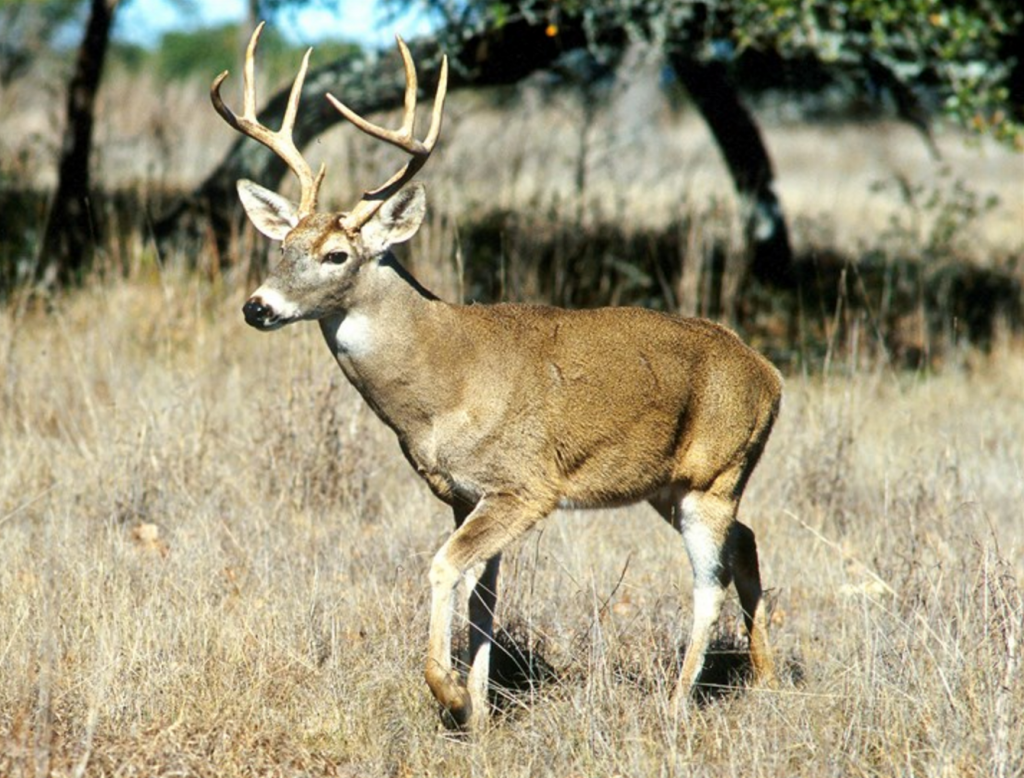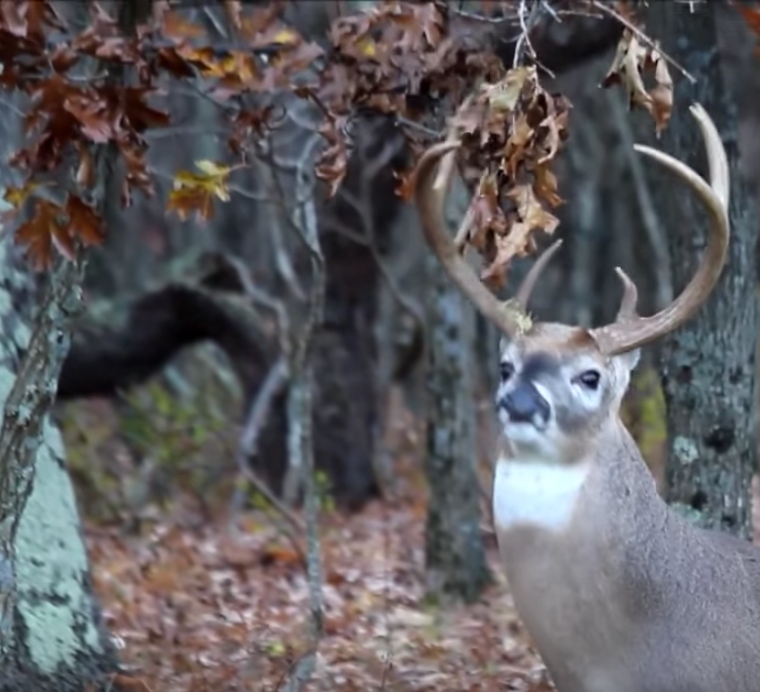
The meat pole back home was still empty. Gun season was in its finale days. Though the whitetails had been pushed hard all over Waldwick Township, they were surely still here. But where?
I had just finished unsuccessfully combing almost every square inch of the three brushy woodlots on the hill-county dairy farm where we were hunting, trying to roust a whitetail for my dad or me to shoot. “Why don’t you wait here?” I suggested as I huffed up to Dad at the intersection of two fencelines. “I’m going to go check out those oak trees across the hayfield.”
Swinging behind some rolls in the landscape to stay out of sight and get the wind in my favor, I approached the trees from above. The “grove” consisted of two old bur oaks and some remnant prairie grass on a side- hill too steep to mow. A few downed branches littered the ground. The place’s footprint wasn’t quite the size of a baseball diamond’s infield.
As I stopped and watched from maybe 30 yards away, trying to decide where to best walk through the tiny patch of bunny cover, a movement in one of the blowdowns caught my eye. As I instinctively raised the slug gun to my shoulder, three whitetails rose from the branches.
DIGGING UP A DEER
We live in a day and age of sedentary hunting techniques: Pick out a good spot and wait out your white- tail. That’s an effective approach to getting your deer … as long as the deer are moving.
But sometimes whitetails aren’t willing to travel, when hunting pressure has them hunkered down and hiding low, with no intentions of moving during daylight hours. Then it’s time to go on the offensive and dig up your deer.
But where do you look? One option is the traditional kinds of hideouts where you expect to find whitetails. Examples include big woodlots, secluded marshes, thick wetland edges, expansive thickets and deep swamps.
There’s another option. Go where other hunters never bother to go. These are the kinds of places where whitetails can bask in seclusion and safety … until you show up on their doorstep. I call it off-the-grid whitetail hunting.
Whether you’re carrying only a buck tag or working to fill an antlerless license, look for your next whitetail in these kinds of off-the-grid hideaways — nooks, crannies, escapes, refuges and sanctuaries that are right under your nose. Here are eight to get you started.
NO. 1: HOMESTEAD HIDEAWAYS
On the prairies and Great Plains where I do much of my whitetail hunting, deer love to hole up around old farmsteads.
Abandoned lots come to mind first — those places with a dilapidated old house or barn and maybe a left- over shed or two, but not much else. There might still be a few trees and old shrubs or lilacs around for cover, and likely some grass, goldenrod or thistles. Whitetails don’t mind the buildings at all. What matters is that the deer find seclusion. Nobody both- ers them.
If you can get permission to do so, it’s worth trying to push through the back lots of active farmsteads, too. These places are often surrounded by a grove of evergreens, hardwoods and brush. One farmer in western Minnesota lets us push the patch of woods behind his place … as long as the hunters doing the pushing don’t carry weapons so close to his house and livestock! The trick is posting standers at the right spots across the fields.

NO. 2: FORGOTTEN CORRALS
Staying on the prairies, plains and farm lands for a moment: It’s worth taking some time to investigate and actually hunt old, forgotten and aban- doned corrals. These places once served as staging areas for gathering and shipping livestock, and though there usually aren’t trees and brush around, the grass, weeds, posts and structures can serve as cover enough — along with the seclusion — to harbor whitetails.
I first discovered old corrals as potential whitetail hotspots the hard way. A hunting partner and I pulled up to a Nebraska corral to park before heading down into more traditional river-bottom cover to hunt. The buck that lumbered away, as our pickup doors opened, made me wish we had glassed and hunted the spot first. I’ve not made that mistake again.
NO. 3: ROADSIDE DITCHES
It’s amazing how roadside ditches can produce whitetails. The attraction here is often cattails, which often grow densely in the wet borrow pits of country roads. A little vehicle traffic doesn’t seem to bother the deer, which have no reservations about bedding here. Even if a truck does drive by, it’s no problem for a whitetail to stay hidden.
In fact, whitetails often take that same sit-tight approach when a hunter works on by.
Every gun season, my friend Dustin pushes a whitetail or two out of roadside ditches found in the farmlands of far western Minnesota. Sometimes the whitetails get away, even when you walk slowly and pause a lot. Last year, one big buck let him go on past, then it sneaked out the back door. A hunting partner hollered, but by then it was too late: The wide-racked 10-pointer was now hightailing away, already far out of slug range.
NO. 4: JUNK DUMPS
One of my favorite old hideaways on a southern Wisconsin farm was an unused cow pasture that, off in one corner, doubled as a parking spot for retired plows, hay rakes, planters, hay wagons and other farm machinery. Grass, brambles and raspberry canes grew all over. Who would ever
think to hunt there?
I discovered the place’s attractiveness to whitetails quite by accident. While preparing for a more conventional push to happen in the woods nearby, I paused there to sit down on an old hay rake and wait for my standers to get into position. After 15 minutes, as I stood up to go start my push, a buck popped up and bounded away!
I couldn’t shoot because he was headed in my posters’ direction. But they were on the ball and one of them shot the deer, even though he showed up before expected!
After that, the spot became a hunting spot of its own. I have also found whitetails hiding out in the country “dumps” that farmers used to use in the forgotten corners and gullies of their properties.
NO. 5: RABBIT COUNTRY
I still remember the day. We had our deer and were hunting rabbits while deer season was still open. It was good to have our hounds out when they otherwise would have been cooped up, and we were hunting a brushy railroad right-of-way through farm country.
Rounding a bend, we unexpectedly saw some other hunters coming our way. Dad and I were further surprised to realize they were deer hunters. They waved, and I hollered to keep an eye out for our dogs. A deer must have been slinking between our parties, because it bounded from the cover.
The deer hunters got the whitetail (with quite a shot by the way), and as we helped them field dress the doe, I plied them for their hunting techniques in these narrow bands of bunny cover.
One of their best strategies was to place a “sneaking” or quiet hunter ahead of the pushers who worked through the cover on either side of the opening, and one quiet hunter trailing all of the commotion. This way the team got chances at deer sneaking ahead, as well as whitetails sneaking out the backdoor. I’ve put the approach to work in strip cover many times since.
Specific approaches aside, the lesson here is clear: If there’s enough cover to hide a cotton-tailed rabbit, there’s enough to hide a cotton-tailed deer!
NO. 6: BARNYARD HIDEAWAYS
One of my favorite all-time whitetail coverts was a patch of weeds, grass and cattails behind a friend’s barn. The place covered maybe the footprint of a city block. Once the surrounding wetlands and wood- lots got worked, the place seemed to attract deer.
You needed only one hunter to push the place. I always volunteered to do the pushing — working the patch slowly, methodically, and with a lot of waiting to make the whitetails nervous. They always held very tight, and you would almost have to step on them before they moved.
One of my nicest bucks ever came out of there. While I was on a pause between movements, the 9-pointer ran in to the hideaway from somewhere else. Lucky, yes. But also in the right place and off the grid.
The place still exists, but it got pastured for a few years by a new owner. He has since removed the cows, and I’m hoping the spot will come back after a few years of rest and vegetation growth. But the lesson is clear: A place doesn’t have to be expansive or far off in the hinterlands to harbor whitetails.

NO. 7: OPEN STUBBLE FIELDS
Most off-the-grid whitetail hotspots are small. But some are big. And wide open. Enter the stubble field.
A fresh-cut grain field serves as an unexpected whitetail hideout that few hunters bother to glass or check out. Deer love the vistas available — being able to see danger coming from forever, and then jogging out in a safe direction.
Corn stubble is best, if the stalks haven’t been chopped for silage. Whitetails can get between rows, bed down and be somewhat hidden. Wheat stubble is good, too, where spring wheat is grown and the stubble is allowed to stand through hunting season. Soybean stubble seems least productive: It’s just too barren for comfort out there.
NO. 8: FENCELINES
Although they are getting more scarce these days, a good old-fashioned fence line separating fields offers whitetails a great place to get off the grid and hide out. Though fence lines are usually used as travel corridors between coverts, smart deer looking for seclusion learn to slip into the cover and sit tight.
A careful, slow, stealthy and patient approach is essential when hunting a fenceline. Barge along and you’ll either make deer run long before you arrive, or you’ll blunder right past them. As with other strip cover, it’s good to post someone ahead, or off to the side at a strategic spot. Using a trailing hunter is often a productive approach, too.
The element of surprise must have been on my side. The hayfield oak grove whitetails hesitated after rising, and my slug found its mark on one of the does. A few seconds earlier, I had been wondering what a winter without venison was going to look like. Now I was walking up to a beautiful whitetail on the ground. I knelt down at her side and thanked my lucky stars, up there somewhere behind the bright blue November sky, that I had taken the extra time and effort to look for whitetails off the grid.
— Tom Carpenter is an avid bowhunter and gun-hunter from Minnesota.
